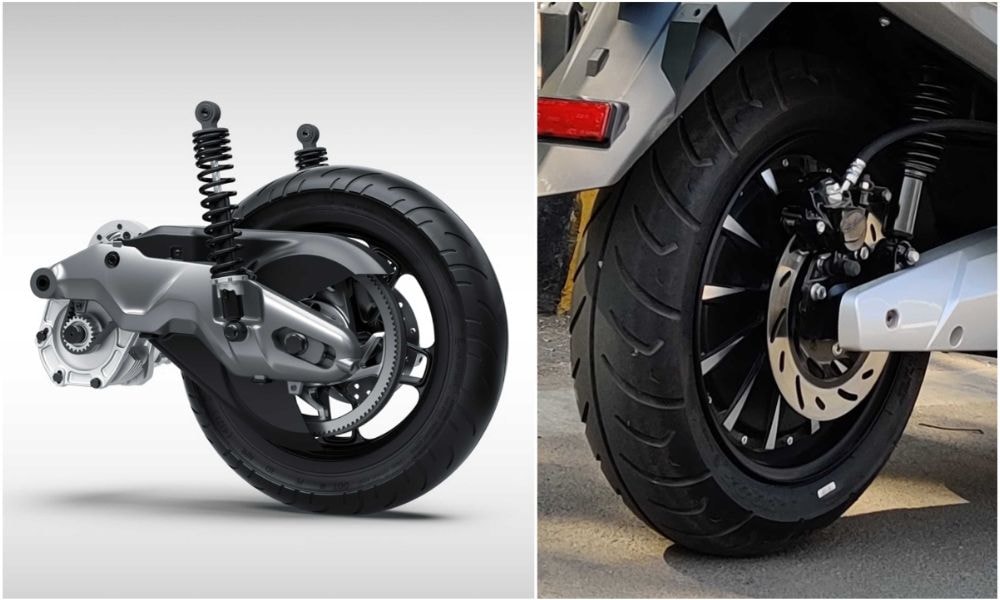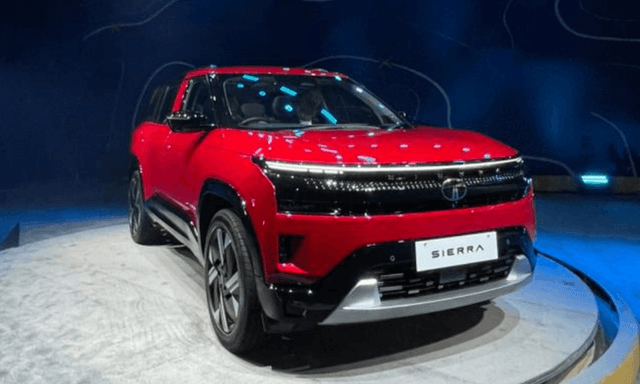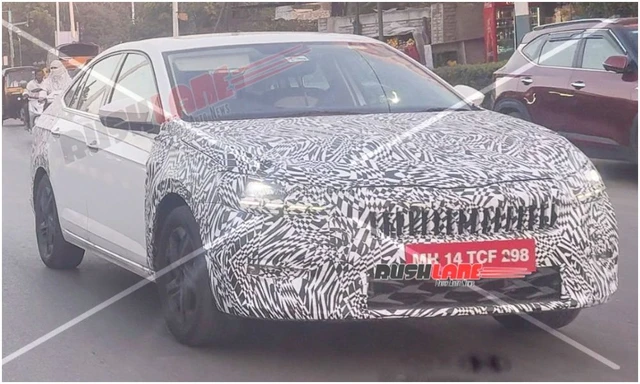Mid-Mounted Motor vs Hub Motor: Key Differences India’s Electric Scooter Buyers Should Know

- Most of the top 10 highest-selling electric two-wheeler brands offer scooters with hub motors.
- Mid-mounted motors used by a select few; aimed at delivering better performance and reliability.
- Long-term durability, lower efficiency and packaging constraints remain concerns for hub motors.
Back when smartphones were still a relatively new concept, buyer attention was mainly focused on the headline figures – the total number of megapixels on offer, the amount of gigabytes of RAM and so on. It was only much later that smartphone discourse matured to include the system-on-chip (SoC), camera sensors and other aspects that greatly influence user experience. Something similar has played out in India’s fast-evolving electric two-wheeler market, where so far, buyers have prioritised a product’s advertised range, battery capacity, power figures and charge times over all else. However, one key area that perhaps warrants more attention than it presently attracts is what powers an electric two-wheeler – its motor (and its positioning).
Today, a majority of electric scooters on sale in India employ one of two main types of motors – a permanent magnet synchronous motor (PMSM), or a brushless DC (BLDC) motor. And even the structural integration of these types of motors, at least in the Indian context, can be divided into two main categories – mid-mounted (located within the scooter’s frame), and hub-mounted (positioned within the scooter’s rear wheel rim).
Also Read: Ola Electric Slashes Prices Of S1 Scooter Lineup By Up To Rs 25,000
Most brands in India sell electric scooters fitted with BLDC hub motors.
More than half of the top 10 highest-selling electric two-wheeler brands in the country today sell at least one model fitted with a hub motor. Market leader Ola Electric’s S1 Air and S1 X models have a hub motor, while TVS’ iQube also uses one. Other players, including Hero Electric, Okinawa, Ampere (Greaves Electric Mobility), Kinetic Green, Bounce, Pure EV, all sell two-wheelers that primarily employ hub motors. The hub motors used by almost all of these brands are BLDC, save for Ola, which says it uses hub-mounted PMSMs.
Mid-mounted motors help reduce unsprung mass and provide greater packaging flexibility.
On the other hand, startups Ather Energy and River have adopted a mid-mounted motor for their scooters. The performance-oriented Ola S1 Pro, and TVS’ X, too, have a mid-mounted PMSM. Bajaj’s Chetak and Hero MotoCorp’s Vida V1, meanwhile, use a swingarm-mounted PMSM.
Hub Motors Convenient, But…
On the face of it, a BLDC hub motor brings benefits of cost (compared to a PMSM) and eliminates the need for a transmission, as it is compact enough to be integrated into the wheel hub, which it powers directly. It’s also notably silent on the move. However, its power density is not on the same level as that of a PMSM.
“BLDC hub motors are relatively simple and easy to integrate into an entry-level EV. The absence of a transmission makes it attractive, both from a cost as well as a maintenance and upkeep point of view”, said an executive working with a leading two-wheeler manufacturer, requesting anonymity.
Also Read: Qargos F9 Cargo e-scooter Unveiled; Has A 225 Litre Storage Capacity
Hub motors eliminate the need for a transmission, and are generally quite silent in operation.
However, the benefits of a BLDC hub motor – which is now produced and sold by several motor manufacturers in the country – are heavily outweighed by its downsides, as per some industry officials. One of these is efficiency – a PMSM offers efficiency levels of well over 90 per cent, which is notably higher than a comparable BLDC hub motor.
“BLDCs are fundamentally simpler. The manufacturing is simpler. Investment is lower. The engineering and motor control algorithms required are much simpler on a BLDC than on a PMSM. So the barriers to entry [for production and sales] are much lower there. Efficiency [compared to a PMSM] is significantly lower, which means for the same battery capacity, you’re going to achieve lesser range”, explains Arjun Jain, CEO of components firm Varroc, which has been making traction motors for EVs since 2022.
Hub Motors: Impact On Durability And Performance
There are also several factors relating to hub motors that impact vehicle performance and dynamics. Opting for a hub motor can lead to a four or even five-fold increase in wheel assembly weight [compared to the rear wheel of a mid-mount motor scooter]. The substantial increase in unsprung mass poses tall hurdles for suspension tuning and vehicle handling.
Performance-oriented electric scooters such as the TVS X have a mid-mounted permanent magnet motor.
“A fundamental problem with a hub motor is the stator windings won’t be able to cool themselves efficiently as opposed to a mid-mounted motor. You will have to reduce the amount of maximum torque the motor can deliver. If you choose to increase the torque levels, the consistency of that torque being repeatedly available will take a massive hit because of the windings getting hotter. Aside from the increase in unsprung mass (which negatively impacts ride quality), with a hub motor, you also have a large chunk of mass going further away from the centre of gravity of the vehicle. The yaw inertia of the vehicle will shoot up, making it harder to turn the vehicle – even when executing a simple U-turn”, explains Shivaram NV, chief engineer at Ather Energy.
What’s more, from an overall vehicle cost point of view, a hub motor does not always work out cheap.
Also Read: Yamaha Acquires Stake In Electric Two-Wheeler Startup River With Over $20 Million Investment
Pairing a gearbox with a mid-mounted motor enables torque multiplication at a comparatively lower cost, according to Ather co-founder Swapnil Jain.
“If you look at the overall vehicle, the system costs of having a PMSM for the same amount of [targeted] range is lower than for a hub motor. You might pay a little bit more for the motor and the motor controller, but you save a lot on battery, assuming the same amount of range”, says Jain.
His view is seconded by Ather Energy co-founder Swapnil Jain, who says, “The difference in cost between a mid-mount and a hub motor is only perceived. To match the performance of a mid-mounted motor, a hub motor won’t just be costlier but also heavier. Increasing torque works out cheaper if you use a gearbox instead of a hub motor. Because of the inherent thermal problems posed by the latter, you have to push in more copper, which bumps up the cost”.
Instances of water seepage in hub motors have been reported, which could be potentially disastrous.
More importantly, there are serious concerns about the longevity and durability of hub-mounted motors. Being positioned lower, they are subjected to prolonged exposure to water, dust and slush, as opposed to a mid-mounted motor, which is usually tucked into the scooter’s frame and protected by the bodywork. Because of where they are located, hub motors are also likely to take quite a beating over Indian roads, and potential repair or replacement work can be not just time-consuming, but also expensive.
“There have been reports of customers facing issues of water seepage, even in motors that have an IP rating, as Indian road and weather conditions wear down the motor casings over time. There have also been instances of the hub being bent out of shape, magnets in the motor breaking, untrained service staff mishandling the motor while disassembling the wheel/tyre, and the cost of replacing a damaged hub motor may be anywhere between Rs 12,000 to Rs 15,000”, says Sanjeev Vasdev, owner and MD of components manufacturer Flash Electronics, which has been producing PMSMs for EVs since 2021.
Mid-Mounted Or Hub: Which One's For The Future?
While today there are several two-wheelers fitted with hub motors, the industry appears to be shifting in favour of mid-mounted motors.
“A hub motor has to fit into the diameter and thickness of the wheel. Mid-mount motors do not have these constraints and in terms of how you want to tune the performance of the vehicle, you have a lot more flexibility. If you want an EV that can compete with an Activa on performance, you cannot have a BLDC motor. If you want moped levels of performance, sure, but I don't expect the market to be at that level”, says Varroc’s Arjun Jain, whose company now focuses on making PMSMs instead of BLDC motors.
Ather initially evaluated, but ended up dropping the prospect of using a hub motor for its upcoming Rizta e-scooter.
Ather’s Swapnil Jain admits the company had initially considered going with a hub motor for its second model, the family-oriented Ather Rizta, but the negatives associated with the motor architecture are consistent, and possibly permanent.
“We never considered it for the 450 lineup, but with the Rizta, we did evaluate it. However, we realised that hub motors still do not make sense, and that realisation is so clear, that we'll probably never go with a hub motor architecture in the future. There’s just a lot more trade offs, and in the long run, it's not a smart architecture”, he says.
As the market matures and consumers start to look a little closer at each electric two-wheeler, it’s a given that more questions will be asked, and customer preferences will start to shape powertrain strategies of electric two-wheeler manufacturers, both in terms of the headline figures as well as the little details that cumulatively make for a fulfilling riding and ownership experience.
Trending News
Latest News
 car&bike Team | Dec 14, 2025Top-Spec Tata Sierra Accomplished, Accomplished+ Prices RevealedRegardless of the powertrain combination chosen, all Tata Sierra Accomplished+ trims cost upwards of Rs 20 lakh (ex-showroom).2 mins read
car&bike Team | Dec 14, 2025Top-Spec Tata Sierra Accomplished, Accomplished+ Prices RevealedRegardless of the powertrain combination chosen, all Tata Sierra Accomplished+ trims cost upwards of Rs 20 lakh (ex-showroom).2 mins read car&bike Team | Dec 13, 2025Skoda Slavia Facelift Spied Testing Again Ahead Of DebutThe facelifted Slavia is expected to debut in 2026 as Skoda-VW India looks to refresh its India 2.0 range.1 min read
car&bike Team | Dec 13, 2025Skoda Slavia Facelift Spied Testing Again Ahead Of DebutThe facelifted Slavia is expected to debut in 2026 as Skoda-VW India looks to refresh its India 2.0 range.1 min read car&bike Team | Dec 13, 20252026 MG Hector Facelift Interior Previewed Ahead Of DebutLatest teaser video of the upcoming Hector facelift suggests minimal cosmetic changes to the interior as well as reveals a new alloy-wheel design.1 min read
car&bike Team | Dec 13, 20252026 MG Hector Facelift Interior Previewed Ahead Of DebutLatest teaser video of the upcoming Hector facelift suggests minimal cosmetic changes to the interior as well as reveals a new alloy-wheel design.1 min read Jaiveer Mehra | Dec 13, 2025Passenger Vehicle, Two-Wheeler Sales Surge In November 2025: SIAMBoth segments reported a growth in the region of 20 per cent, though year-to-date sales growth in FY2026 was notably flatter at around 3 per cent.1 min read
Jaiveer Mehra | Dec 13, 2025Passenger Vehicle, Two-Wheeler Sales Surge In November 2025: SIAMBoth segments reported a growth in the region of 20 per cent, though year-to-date sales growth in FY2026 was notably flatter at around 3 per cent.1 min read car&bike Team | Dec 12, 2025Nissan Entry MPV Design To Be Unveiled On December 18New MPV to be the first of three new models for India by Nissan, alongside the Tekton and a three-row SUV.1 min read
car&bike Team | Dec 12, 2025Nissan Entry MPV Design To Be Unveiled On December 18New MPV to be the first of three new models for India by Nissan, alongside the Tekton and a three-row SUV.1 min read Jaiveer Mehra | Dec 12, 2025New Mini Convertible Launched At Rs 58.50 LakhDrop-top variant of the iconic Cooper hatchback available in a single Cooper S spec.1 min read
Jaiveer Mehra | Dec 12, 2025New Mini Convertible Launched At Rs 58.50 LakhDrop-top variant of the iconic Cooper hatchback available in a single Cooper S spec.1 min read
 Janak Sorap | Dec 11, 2025Harley-Davidson X440 T First Ride Review: Smarter and SharperHarley-Davidson has taken the X440 and given it a more focused and engaging twist. The result is the X440 T—essentially the same platform but updated in areas that give the motorcycle more appeal and riders more thrill.5 mins read
Janak Sorap | Dec 11, 2025Harley-Davidson X440 T First Ride Review: Smarter and SharperHarley-Davidson has taken the X440 and given it a more focused and engaging twist. The result is the X440 T—essentially the same platform but updated in areas that give the motorcycle more appeal and riders more thrill.5 mins read Shams Raza Naqvi | Dec 10, 20252025 Mini Cooper Convertible Review: More Colour On Indian RoadsThe updated Mini Cooper Convertible is set to be launched in the Indian market in the next few days. We drive it around Jaisalmer for a quick review.1 min read
Shams Raza Naqvi | Dec 10, 20252025 Mini Cooper Convertible Review: More Colour On Indian RoadsThe updated Mini Cooper Convertible is set to be launched in the Indian market in the next few days. We drive it around Jaisalmer for a quick review.1 min read Bilal Firfiray | Dec 8, 2025Tata Sierra Review: India’s New Favourite?Marking its return after a few decades, the reborn Sierra has made everyone sit up and take notice. But is it worth the hype?10 mins read
Bilal Firfiray | Dec 8, 2025Tata Sierra Review: India’s New Favourite?Marking its return after a few decades, the reborn Sierra has made everyone sit up and take notice. But is it worth the hype?10 mins read Girish Karkera | Dec 4, 20252026 Honda Prelude First Drive: Domesticated Civic Type RA sporty-looking coupe built to give customers a taste of performance but not at the expense of everyday practicality.5 mins read
Girish Karkera | Dec 4, 20252026 Honda Prelude First Drive: Domesticated Civic Type RA sporty-looking coupe built to give customers a taste of performance but not at the expense of everyday practicality.5 mins read Seshan Vijayraghvan | Nov 29, 2025Mahindra XEV 9S First Drive Review: Big Electric SUV, Bigger ExpectationsThe XEV 9S lands at a time when the EV crowd is growing fast. It’s a big, born-electric, three-row SUV that starts under 20 lakh. It sits close to the XUV700 in size, but the brief is very different. Here’s what it’s like on the road.11 mins read
Seshan Vijayraghvan | Nov 29, 2025Mahindra XEV 9S First Drive Review: Big Electric SUV, Bigger ExpectationsThe XEV 9S lands at a time when the EV crowd is growing fast. It’s a big, born-electric, three-row SUV that starts under 20 lakh. It sits close to the XUV700 in size, but the brief is very different. Here’s what it’s like on the road.11 mins read

































































































































